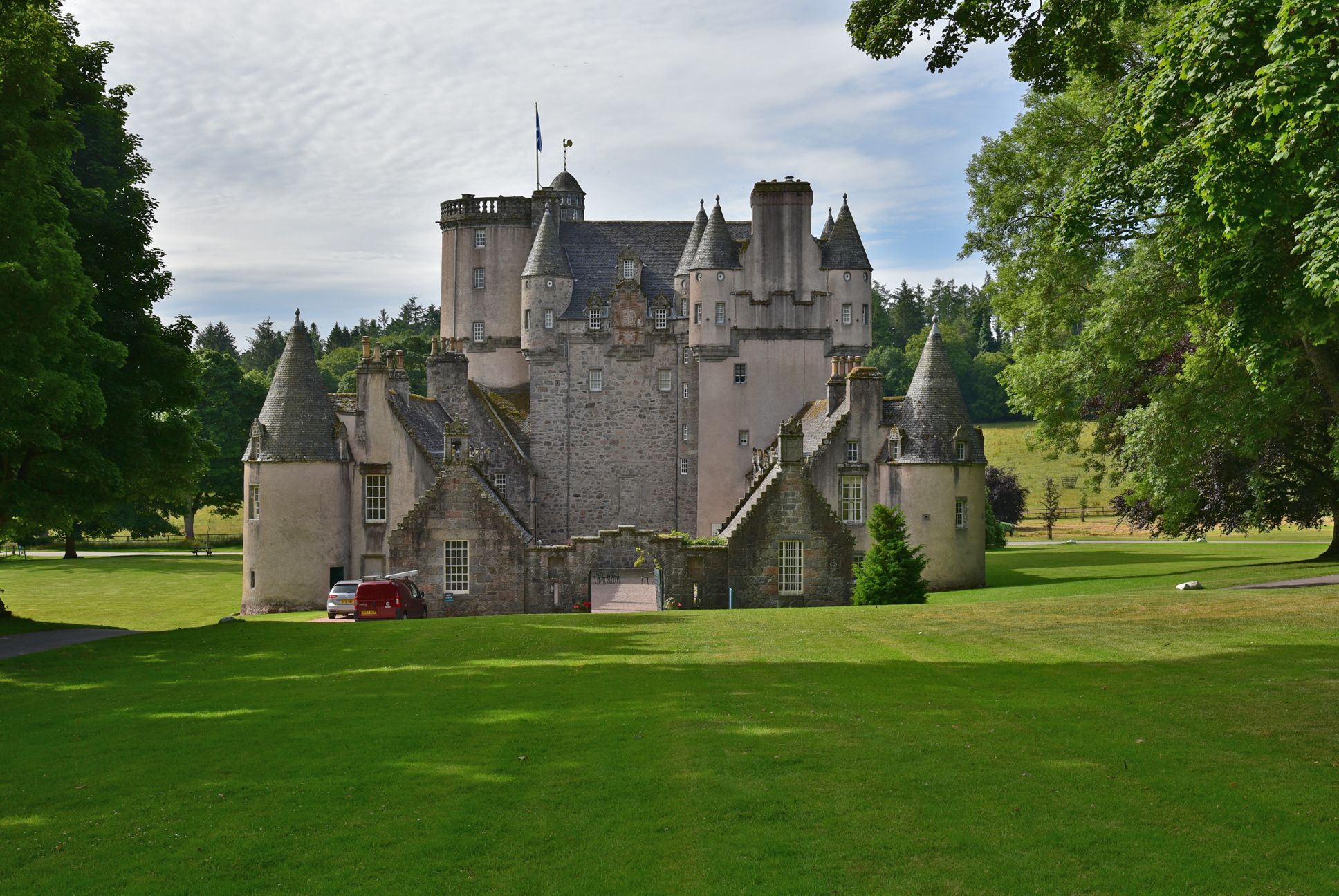History
Castle Fraser resides in a shallow glen south of the River Don. The castle was constructed from native granite by local masons. In the mid-15th century, King James II had control of the ancient earldom of Mar and began settling supporters on those lands. On October 29th, 1454, the lands of Muchall and Stoneywood were formed into a barony and granted to Thomas Fraser in exchange for his lands at Cornton. Castle Fraser stands on the lands of Muchall. The original castle began as a rectangular stone-vaulted defensive tower house sometime after 1454.

In 1575, Michael Fraser, 6th Laird Fraser, converted the stone tower house into a more baronial Z-style castle by adding the Round Tower and a smaller square tower to opposite corners of the tower house. These additions were completed by 1636. A panel on the northern side of the castle is marked with "I Bel," believed to be the mason mark of the master mason John Bell of Midmar, who worked on creating the Z-plan design along with master mason Thomas Leiper.
The second Lord Fraser, Andrew Fraser, opposed King Charles I's introduction of the Prayer Book, Laud's Liturgy, in Scotland in 1637 and became a supporter of the Covenant the following year, which pledged to maintain the Presbyterian Church and Scotland's laws and liberties. The following year, he hosted a group of Covenanters at Castle Fraser, including James Graham, the Earl of Montrose, who would soon change sides and become the King's lieutenant in Scotland.
In 1644, Royalist forces under James Graham, now the Marquess of Montrose, sacked the castle, causing extensive damage to its interior.
In the late 18th century, Castle Fraser underwent further changes as it was modernized in a classical style, featuring a new entrance on the castle's south side and the addition of sash windows. Elyza Fraser, the Lady Laird, and Mary Bristow carried out these changes, which also saw the original formal gardens and orchards removed and replaced by a stable block.
In 1897, the last male Fraser, Frederick Mackenzie Fraser, died childless. In 1921, his widow sold the castle due to the lack of a suitable heir and mounting debt. The castle was purchased by Weetman Pearson, 1st Viscount Cowdray, who restored the castle as a shooting lodge and gave it to the National Trust for Scotland in 1976.
Castle Highlights
Castle Fraser is a well-preserved and the most elaborate Z-plan castle in Scotland, featuring a large central tower house with the Round Tower at one corner and a square tower at the opposite corner. Two wings projecting from the castle create a courtyard enclosed by a stone-arched gateway. The buildings in these wings currently house the gift shop and café. The tower house stands four stories tall and has an attic. The Round Tower rises two stories taller than the house.
The Great Hall is the largest room in the castle, used to host banquets, and features portraits of the Fraser family, including Lieutenant-General Alexander Mackenzie Fraser, above the fireplace.
The Michael Kitchen, named after Laird Michael Fraser (1588), fed the castle's 30-40 workers. A massive fireplace fills the north wall with brick fragments of a bread oven set inside it.
The 17th century Dining Room was used for entertaining guests, and the Victorian dining table seats over 20 people. There is a portrait of the Duke of Wellington in the Dining Room. Alexander Mackenzie Fraser and his son Charles served under Wellington during the Napoleonic Wars.
The Worked Room is named after the 18th century needlework bed hangings, curtains, and seat furniture that adorn the room. The most curious feature of this room is a door on the southwest corner that leads to a trap door opening into the "Laird's Lug," a secret room used by the Laird to eavesdrop on conversations in the Great Hall.
Castle Fraser also has a walled garden that once gave the castle fruit, vegetables, and flowers. The garden also included a vineyard and two peach houses. Additionally, several walking paths are located near or around the castle.
Castle Fraser can be thoroughly explored in half a day. To make a full day of visiting castles, Craigievar Castle and the ruins of Kildrummy Castle are further to the west.
Castle Fraser is also haunted.


